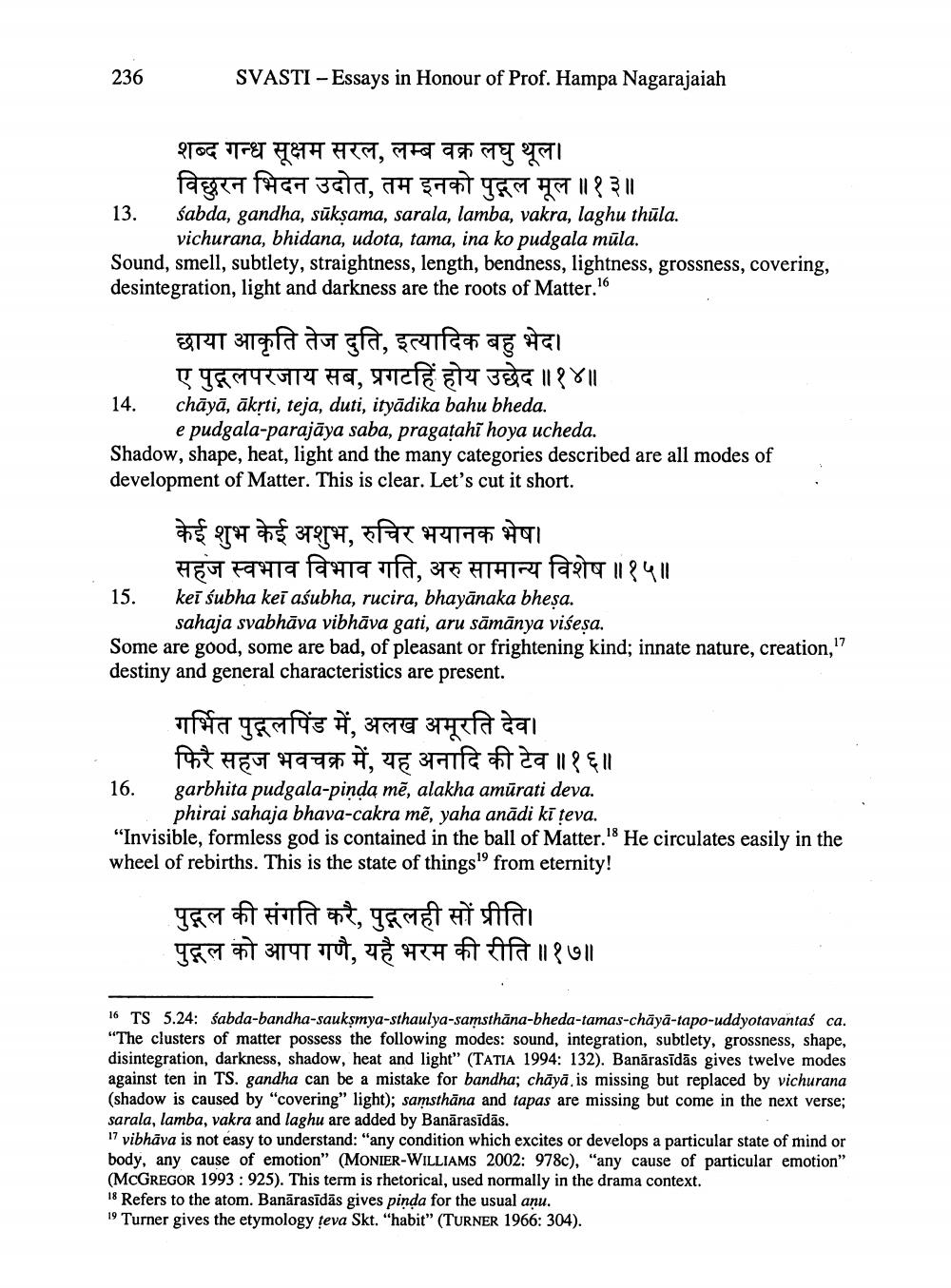________________
236
SVASTI - Essays in Honour of Prof. Hampa Nagarajaiah
शब्द गन्ध सूक्षम सरल, लम्ब वक्र लघु थूल।
विठुरन भिदन उदोत, तम इनको पुल मूल ॥१३॥ 13. Sabda, gandha, suksama, sarala, lamba, vakra, laghu thula.
vichurana, bhidana, udota, tama, ina ko pudgala mūla. Sound, smell, subtlety, straightness, length, bendness, lightness, grossness, covering, desintegration, light and darkness are the roots of Matter.16
छाया आकृति तेज दुति, इत्यादिक बहु भेद।
ए पुद्लपरजाय सब, प्रगटहिं होय उछेद ॥१४॥ 14. chāyā, āksti, teja, duti, ityādika bahu bheda.
e pudgala-parajāya saba, pragatahi hoya ucheda. Shadow, shape, heat, light and the many categories described are all modes of development of Matter. This is clear. Let's cut it short.
केई शुभ केई अशुभ, रुचिर भयानक भेष।
सहज स्वभाव विभाव गति, अरु सामान्य विशेष ॥१५॥ 15. kei subha kei aśubha, rucira, bhayānaka bheşa.
sahaja svabhāva vibhāva gati, aru sāmānya višesa. Some are good, some are bad, of pleasant or frightening kind; innate nature, creation,17 destiny and general characteristics are present.
गर्भित पुर्लपिंड में, अलख अमूरति देव।
फिरै सहज भवचक्र में, यह अनादि की टेव ॥१६॥ 16. garbhita pudgala-pinda mē, alakha amūrati deva.
phirai sahaja bhava-cakra mē, yaha anādi ki teva. "Invisible, formless god is contained in the ball of Matter. He circulates easily in the wheel of rebirths. This is the state of things from eternity!
पुद्गल की संगति करै, पुदलही सों प्रीति। पुद्गल को आपा गणै, यहै भरम की रीति ॥१७॥
16 TS 5.24: sabda-bandha-sauksmya-sthaulya-samsthāna-bheda-tamas-chāyā-tapo-uddyotavantaś ca. "The clusters of matter possess the following modes: sound, integration, subtlety, grossness, shape, disintegration, darkness, shadow, heat and light" (TATIA 1994: 132). Banārasīdās gives twelve modes against ten in TS. gandha can be a mistake for bandha; chāyā, is missing but replaced by vichurana (shadow is caused by "covering" light); samsthāna and tapas are missing but come in the next verse; sarala, lamba, vakra and laghu are added by Banārasīdās. 17 vibhāva is not easy to understand: "any condition which excites or develops a particular state of mind or body, any cause of emotion" (MONIER-WILLIAMS 2002: 978c), "any cause of particular emotion" (MCGREGOR 1993: 925). This term is rhetorical, used normally in the drama context. 18 Refers to the atom. Banārasīdās gives pinda for the usual anu. 19 Turner gives the etymology teva Skt. "habit" (TURNER 1966:304).




